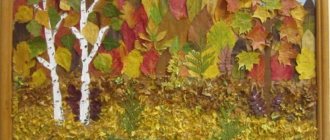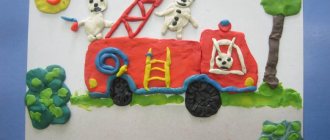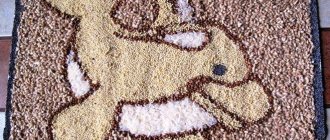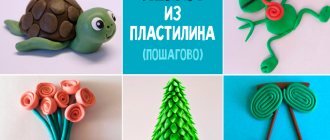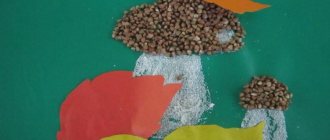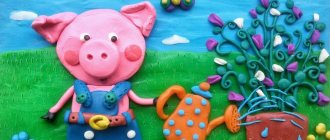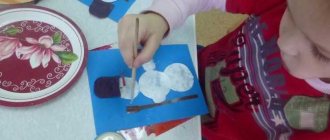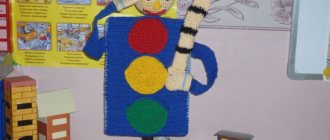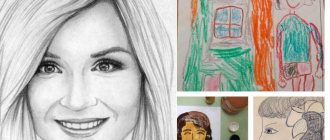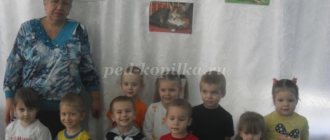Paper applications
For the most exciting form of such leisure time and instilling initial creativity skills in preschool age, materials are usually prepared in advance.
The set of handy tools is already quite familiar: colored paper, glue, templates and scissors. Depending on the age category, simpler or more complex figures are chosen.
The principle of operation is as follows. The colored picture is cut into pieces, after which the child assembles it like a puzzle and pastes it onto a sheet of paper.
You can complicate the task by coloring the black and white image yourself, followed by cutting and sticking. This will make the process even more interesting.
As an alternative, you can create a separate representative of the fauna or a whole composition from prepared parts - torso, head, paws and tail. Showing patience and accuracy, the child tries very hard to create a unique image.
Pets
All kids know what the pets that live in grandma's house or yard look like. Older children know that, in addition to cats, dogs and rabbits, domestic animals also include cows, goats, sheep and horses.
By jointly remembering all the inhabitants of apartments and garden plots, you can make a beautiful applique.
Cat
Cut out the constituent elements: round head, oval body, paws, tail and ears from ¼ circle. The picture is assembled and painted. An adult can print geometric shapes on a printer in advance, and then build a kitten from the photo.
Dog
The figure is also not difficult, like the previous one. In addition to auxiliary materials, you will need blanks. The eyes, body and front paw are formed from ovals, the head from a whole circle, and the back paw and ears from halves.
Piglet
The body, legs, head, tail, ears are cut out of colored paper, and for the face: nose, eyes and snout. Children are asked to connect all the components and stick them on paper to create the appearance of a pig. It will look more fun if you make the tail voluminous.
Cow
Since at the age of 3-4 years it is quite difficult to cut out small details of the applique, you can use templates, which are subsequently glued onto a green sheet of paper.
The composition with a herd grazing in a meadow looks especially impressive. To prevent the process from seeming too labor-intensive, several cows are painted.
To improve perception, colors are selected for the background: light green, deep green or grass.
Applications with wild animals
They live in the thicket of the forest, so to see them you need to visit the Zoo. When going on an exciting journey, you need to have on hand: scissors, sheets of paper, glue, millet, felt-tip pens and animal figurines.
Bear
In our area, he is the real owner of the forest, so many children want to see him. Sequence of work:
- Pictures of a bear are distributed.
- Using a brush, carefully apply glue to the area where the body is located, precisely following the contour and without violating the boundaries of the design.
- Oatmeal is poured over the glue.
- Wait until completely dry.
The result is an applique extremely similar to Toptygin’s!
Chanterelle
It is best to assemble a fox with a bright fur coat from geometric shapes. The head and ears are triangle-shaped, and the tail, body and paws are oval. The eyes and nose on Patrikeevna's face are drawn with a felt-tip pen.
Bunny made from napkins
In the forests there are not only formidable predators, but also absolutely non-dangerous animals that feed on grass. Step-by-step instructions for the bunny:
- Take white napkins and tear them into small pieces.
- They are formed into balls.
- Bunnies are drawn using templates.
- The lumps are glued to the ears and body.
- The middle of the ears, tail and muzzle are decorated with cotton wool.
- At the final stage, a mustache is made from dark stripes.
This bunny can be placed on a postcard and presented as a gift!
Inhabitants of hot countries
All children are very inquisitive and always ask who is found on the distant southern continents. Using the appliqué technique, you can make exotic animals that you won’t find in your own forest.
Elephant
Typically, appliqué is done using blanks. First of all, the figure is cut out and then glued onto a piece of paper. To complete the composition, select a background that is suitable in color.
a lion
These animals live in the African savanna. Many children have seen live lions at the Zoo, so they can clearly imagine what this king of beasts looks like.
To make the lion cub really cute, you need to thoroughly prepare. You must have: black and red markers or felt-tip pens, PVA glue, a brush, scissors, sheets of yellow and orange paper.
Progress:
- The head and mane are cut out.
- The parts are glued together.
- An orange triangle imitating a nose is placed in the middle.
- They complete the look with eyes drawn at the top with a marker, and a mouth and cheeks at the bottom.
The almost finished craft is dried and set aside for a while. This applique can be used to decorate a greeting card or gift box!
Application “Tabby cat”
Olga Patzer
Application “Tabby cat”
Introduce children to various types of applications (flat, broken, three-dimensional);
learn to do work collectively in groups;
develop imagination, fantasy;
cultivate accuracy when performing work;
cultivate a love for animals.
-develop the ability to stick strips sequentially, use a brush, glue and a napkin;
-develop aesthetic taste, accuracy in work
To make a cat you will need:
Colored paper strips (10 mm wide, A4 paper, scissors, knife, adhesive tape or glue, printing template. brushes.
Progress of the lesson
Organizing time.
Creatures of unearthly beauty.
Who has a cat or kitten at home?
What signs do you know associated with cats?
The teacher tells the children signs. (A cat curls up into a ball - it’s cold. A cat washes itself - wait for guests. At a housewarming party, the cat is the first to be let into the house.)
What fairy-tale cats do you know?
(Puss in Boots, Matroskin the cat, a kitten named Woof, Leopold the cat)
I invite you guys to come up with your own fairy-tale cat. Imagine that there is a Planet of colorful cats. They are everywhere there. For example, look at this portrait.
Where do you think this cat lives?
(Flower cat, Buttercup, Cornflower, Rosette cat, Chamomile, etc.).
Let's look at how this work was done.
(We print the template on plain white paper, although you can use paper of any color, on the front. So that the sheet of paper can then be closed like a postcard. And I cut out the template with a special knife.
From colored paper I cut strips 10 mm wide and at least 14 cm long (for convenience, you can make them longer - then you can simply cut off the excess). The narrower the stripes, the more beautiful.)
Let's make Tabby cats
(The children smeared the strips with glue and glued them on the bottom of the workpiece sequentially, placing them close to each other, without gaps. The color of the strips was chosen according to their design.
I helped the children design their faces and drew them. The striped cats are ready.)
Physical education session “Zverobika”
After watching her a little,
We can repeat her movements.
Summarizing.
— Did you like the colorful cats? What will you call them?
"Kitty." Abstract of the GCD on the application in the second junior group of the direct educational activity “Artistic and Aesthetic Development” (application) on the topic: “Kitty” in the second junior group. "Striped Country" Didactic manual for automating speech sounds Prepared by: teacher-speech therapist of MDOU No. 21 “Rosinka” Lytkarino Makhonina S. R. Correction of the pronunciation of any of the incorrectly pronounced ones. Application “Cat” from semolina Maltseva Elena Aleksandrovna. Teacher of Kindergarten No. 2 of JSC Russian Railways Application “Kitty” made from semolina. Soft cat, affectionate cat.
Game-quiz on traffic rules “Striped Zebra” Municipal budgetary preschool educational institution “Kindergarten No. 9 “Yolochka”, Nurlat RT” Game-quiz “Striped.
Summary of educational activities in the early age group “The cat came to us” Summary of educational activities in the early age group on the topic “The cat came to us.” Author: Olga Aleksandrovna Bataeva, teacher at MBDOU kindergarten.
Summary of a lesson on origami “Cat Maneki-neni” Summary of a lesson on origami “Cat Manekineko” Program content: 1) Educational objectives: Continue acquaintance with Japan, p.
Summary of a lesson on cognitive development “The cat Murka came to visit” Topic: “The cat Murka came to visit.” Goal: To introduce children to the pet cat. Objectives: To cultivate goodwill and responsiveness.
Master class “Kitty” (origami) I bring to your attention a master class “Kitty” made from paper. Origami is a type of decorative and applied art; the art of folding.
Mini-scene “All the kids like the beautiful cat” Characters: in the role of a mother - a speech therapist, in the role of a daughter - a child of the senior group of compensatory orientation, in the role of a teacher - a teacher.
Fauna of the Far North
There are many master classes on the Internet about animals living in permafrost conditions. Children know these waterfowl from books and cartoons.
Panda
The clothes of this exotic animal look very unusual. The procedure for making a panda is as follows. A larger cut out black oval will serve as the body, and a smaller one for the abdomen.
Other components are black paws and a red mouth. All components are attached to the base with glue. The cheerful panda is ready!
Applications are not only made of paper, but also partially made of cotton wool. Most often they decorate the body and head of animals. The material is glued in a solid piece or in the form of rolled balls.
If you paint the cotton wool, you will get a delightful craft.
Multi-colored woolen threads, cereals or plasticine are also used for decoration. This activity is very useful for children, as it teaches perseverance and develops creativity!
"Kitty". Abstract of GCD on application using non-traditional techniques (cotton wool) in the junior group
Alena Loseva
"Kitten". Abstract of GCD on application using non-traditional techniques (cotton wool) in the junior group
SUMMARY OF NODES FOR APPLICATION
IN NON-TRADITIONAL TECHNIQUES (cotton wool) IN THE YOUNGER GROUP.
Tasks.
Educational:
consolidate children's knowledge about pets;
to develop children’s ability to perform appliqué using cotton wool.
Educational:
develop fine motor skills of the hands;
develop creative imagination;
promote the development of children's interest in joint activities with their parents;
promote the development of memory, attention, thinking.
Educational:
cultivate interest in understanding the world around us;
cultivate accuracy when working with glue.
Integration of educational areas: artistic and aesthetic development, cognitive development, speech development, physical development, social and communicative development.
Equipment and materials for the teacher: computer, projector, screen, sample application, sheet of cardboard, kitten template, cotton wool, colored paper in black, blue, red, PVA glue, brush, scissors, pencil.
Handouts: sheets of cardboard, kitten templates, cotton wool, colored paper in black, blue, red, PVA glue, brushes, scissors, pencils.
Preliminary work: talking about domestic animals and their babies, looking at illustrations of domestic animals, solving riddles about domestic animals.
Progress of the lesson.
I. Introductory part.
Educator: Guys, look carefully at the screen. What would you call in one word those depicted on the screen?
Educator: please answer me, which of these animals is the odd one out and why?
Children: the odd one out here is the fox, because the fox is a wild animal, and the rest are domestic animals.
Educator: Guys, what other pets do you know?
Children: goat, horse, cat, etc.
Educator: guys, look carefully at the picture and tell me who is hiding in the picture? (Children name pets)
Educator: How many animals are hidden here? (Children count and answer)
Educator: now we will play the game “Name the Cub.” I will show you pictures of domestic animals, and you will name the animal and the baby. For example, a cat has a kitten. (Children look at the pictures and name them.)
